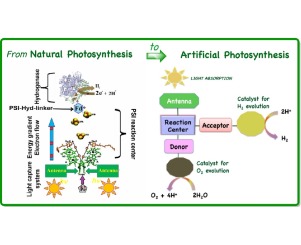Journal of Photochemistry and Photobiology C: Photochemistry Reviews ( IF 13.6 ) Pub Date : 2017-02-20 , DOI: 10.1016/j.jphotochemrev.2017.02.001 Mohamed E. El-Khouly , Eithar El-Mohsnawy , Shunichi Fukuzumi

|
Solar energy has a great potential as a clean, cheap, renewable and sustainable energy source, but it must be captured and transformed into useful forms of energy as plants do. An especially attractive approach is to store solar energy in the form of chemical bonds as performed in natural photosynthesis. Therefore, there is a challenge in the last decades to construct semi-artificial and artificial photosynthetic systems, which are able to efficiently capture and convert solar energy and then store it in the form of chemical bonds of solar fuels such as hydrogen or hydrogen peroxide, while at the time producing oxygen from water. Here, we review the molecular level details of the natural photosynthesis, particularly the mechanism of light dependent reactions in oxygen evolving organisms, absorption efficiency of solar energy and direct energy production. We then demonstrate the concept and examples of the semi-artificial photosynthesis in vitro. Finally we demonstrate the artificial photosynthesis, which is composed of light harvesting and charge-separation units together with catalytic units of water oxidation and reduction as well as CO2 reduction. The reported photosynthetic molecular and supramolecular systems have been designed and examined in order to mimic functions of the antenna-reaction center of the natural process. The relations between structures and photochemical behaviors of these artificial photosynthetic systems are discussed in relation to the rates and efficiencies of charge-separation and charge-recombination processes by utilizing the laser flash photolysis technique, as well as other complementary techniques. Finally the photocatalytic production of hydrogen peroxide as a more promising solar fuel is discussed in relation with the natural photosynthesis, which also produces hydrogen peroxide in addition to NADPH.
中文翻译:

太阳能转化:从自然光合作用到人工光合作用
太阳能具有清洁,廉价,可再生和可持续能源的巨大潜力,但必须像植物一样将其捕获并转化为有用的能源形式。一种特别有吸引力的方法是以自然光合作用的方式以化学键的形式存储太阳能。因此,在过去的几十年中,构建半人工和人工光合作用系统面临着挑战,该系统能够有效地捕获和转换太阳能,然后以太阳能燃料(例如氢或过氧化氢)的化学键形式存储它,而当时从水中产生氧气。在这里,我们回顾了自然光合作用的分子水平细节,尤其是在氧气进化生物中光依赖性反应的机制,太阳能的吸收效率和直接能源生产。然后,我们演示了体外半人工光合作用的概念和实例。最后,我们演示了人工光合作用,它由光收集和电荷分离单元以及水氧化和还原以及CO的催化单元组成2减少。为了模拟自然过程的天线反应中心的功能,已经设计并检查了报道的光合作用分子和超分子系统。通过利用激光闪光光解技术以及其他互补技术,讨论了这些人工光合作用系统的结构与光化学行为之间的关系,以及电荷分离和电荷重组过程的速率和效率。最后,讨论了与自然光合作用有关的光催化生产过氧化氢作为更有前景的太阳能的方法,该光合作用除NADPH外还产生过氧化氢。


























 京公网安备 11010802027423号
京公网安备 11010802027423号